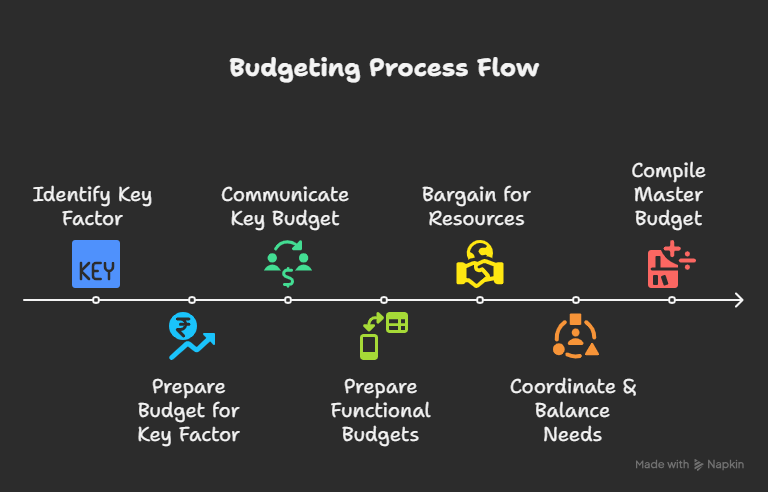Skip to main content
Budgeting Process
What is Budgeting?
-
Budgeting is a structured planning process developed over time.
- It involves all departments and functions within the organization.
- It ensures that departmental goals align with organizational objectives, reducing internal conflicts.
Master Budget
- The final output of the budgeting process.
- A comprehensive blueprint of all planned activities for the year.
- Divided into:
-
Operational Budgets
-
Financial Budgets
1. Operational Budgets
- Expressed in units and monetary value.
- Examples:
-
Sales Budget
-
Production Budget
-
Purchases Budget
-
Labour Budget
-
Overhead Budget
-
Selling & Distribution Expenses Budget
2. Financial Budgets
- Aggregates monetary details from operational budgets.
- Examples:
-
Cash Budget
-
Capital Expenditure Budget
-
Projected Balance Sheet
-
Income Statement
-
Cash Flow Statement
Interdependence of Budgets
- All budget components are interlinked.
- A change in one affects others.
- The process typically starts with identifying the key factor (limiting factor).
Key Factor in Budgeting
- The limiting resource or constraint that influences all other budgets.
- Varies by industry:
-
Sales or Demand → Most common in manufacturing
-
Production Capacity → If machine or manpower is limited
-
Raw Material Availability → In industries like power or pharma
-
Consultant Hours → In professional service firms
Budgeting Process Flow
-
Identify the Key Factor
-
Prepare Budget for Key Factor
-
Communicate Key Budget to Other Divisions
-
Functional Budgets Prepared in Alignment
-
Departments Bargain for Limited Resources
-
Budget Committee Coordinates & Balances Needs
-
Final Master Budget Document is Compiled

- Expected or Planned Sales (Units & Value)
-
Opening & Closing Inventory:
- Raw Material
- Work-in-Progress (WIP)
- Finished Goods
-
Production Schedule
-
Input Requirements:
- Raw Materials
- Labour
- Machine Hours
- Overheads
-
Indirect Costs (Cost Drivers)
-
Credit Policies (For both sales & purchases)
-
Capital Budgeting Proposals
-
Financial Policies & Forecasts:
- Balance Sheet
- Income Statement
- Cash Flow Statement


No Comments